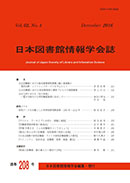Volume 62, Issue 4
Displaying 1-11 of 11 articles from this issue
- |<
- <
- 1
- >
- >|
Article
-
2016Volume 62Issue 4 Pages 221-241
Published: 2016
Released on J-STAGE: January 08, 2017
Download PDF (4566K) -
2016Volume 62Issue 4 Pages 242-254
Published: 2016
Released on J-STAGE: January 08, 2017
Download PDF (1035K) -
2016Volume 62Issue 4 Pages 255-267
Published: 2016
Released on J-STAGE: January 08, 2017
Download PDF (2111K)
-
2016Volume 62Issue 4 Pages 268-278
Published: 2016
Released on J-STAGE: January 08, 2017
Download PDF (725K)
Book Review
-
2016Volume 62Issue 4 Pages 279-280
Published: 2016
Released on J-STAGE: January 08, 2017
Download PDF (566K) -
2016Volume 62Issue 4 Pages 281-282
Published: 2016
Released on J-STAGE: January 08, 2017
Download PDF (592K) -
2016Volume 62Issue 4 Pages 283-284
Published: 2016
Released on J-STAGE: January 08, 2017
Download PDF (594K) -
2016Volume 62Issue 4 Pages 285-286
Published: 2016
Released on J-STAGE: January 08, 2017
Download PDF (601K) -
2016Volume 62Issue 4 Pages 287-288
Published: 2016
Released on J-STAGE: January 08, 2017
Download PDF (547K) -
2016Volume 62Issue 4 Pages 289-290
Published: 2016
Released on J-STAGE: January 08, 2017
Download PDF (577K) -
2016Volume 62Issue 4 Pages 291-
Published: 2016
Released on J-STAGE: January 08, 2017
Download PDF (535K)
- |<
- <
- 1
- >
- >|
